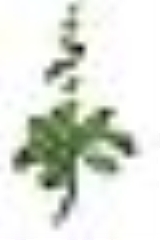
Horminum
Encyclopedia
Horminum is a genus
of flowering plant
s in the family Lamiaceae
, comprising a single species, Horminum pyrenaicum, native to rocky slopes and grasslands in the Pyrenees
and Alps
in western Europe
. Common names include Dragonmouth and Pyrenean Dead-nettle.
It is a perennial plant
growing to 45 cm tall. The leaves
are produced in rosettes, 3-7 cm long and 2-5 cm broad, ovate, glossy deep green, quilted, with a bluntly toothed margin. The flower
s are produced in whorls on the upper stems, dark purple, tubular or bell-shaped, 1.5-2 cm long, with two lips.
Genus
In biology, a genus is a low-level taxonomic rank used in the biological classification of living and fossil organisms, which is an example of definition by genus and differentia...
of flowering plant
Flowering plant
The flowering plants , also known as Angiospermae or Magnoliophyta, are the most diverse group of land plants. Angiosperms are seed-producing plants like the gymnosperms and can be distinguished from the gymnosperms by a series of synapomorphies...
s in the family Lamiaceae
Lamiaceae
The mints, taxonomically known as Lamiaceae or Labiatae, are a family of flowering plants. They have traditionally been considered closely related to Verbenaceae, but in the 1990s, phylogenetic studies suggested that many genera classified in Verbenaceae belong instead in Lamiaceae...
, comprising a single species, Horminum pyrenaicum, native to rocky slopes and grasslands in the Pyrenees
Pyrenees
The Pyrenees is a range of mountains in southwest Europe that forms a natural border between France and Spain...
and Alps
Alps
The Alps is one of the great mountain range systems of Europe, stretching from Austria and Slovenia in the east through Italy, Switzerland, Liechtenstein and Germany to France in the west....
in western Europe
Europe
Europe is, by convention, one of the world's seven continents. Comprising the westernmost peninsula of Eurasia, Europe is generally 'divided' from Asia to its east by the watershed divides of the Ural and Caucasus Mountains, the Ural River, the Caspian and Black Seas, and the waterways connecting...
. Common names include Dragonmouth and Pyrenean Dead-nettle.
It is a perennial plant
Perennial plant
A perennial plant or simply perennial is a plant that lives for more than two years. The term is often used to differentiate a plant from shorter lived annuals and biennials. The term is sometimes misused by commercial gardeners or horticulturalists to describe only herbaceous perennials...
growing to 45 cm tall. The leaves
Leaf
A leaf is an organ of a vascular plant, as defined in botanical terms, and in particular in plant morphology. Foliage is a mass noun that refers to leaves as a feature of plants....
are produced in rosettes, 3-7 cm long and 2-5 cm broad, ovate, glossy deep green, quilted, with a bluntly toothed margin. The flower
Flower
A flower, sometimes known as a bloom or blossom, is the reproductive structure found in flowering plants . The biological function of a flower is to effect reproduction, usually by providing a mechanism for the union of sperm with eggs...
s are produced in whorls on the upper stems, dark purple, tubular or bell-shaped, 1.5-2 cm long, with two lips.

